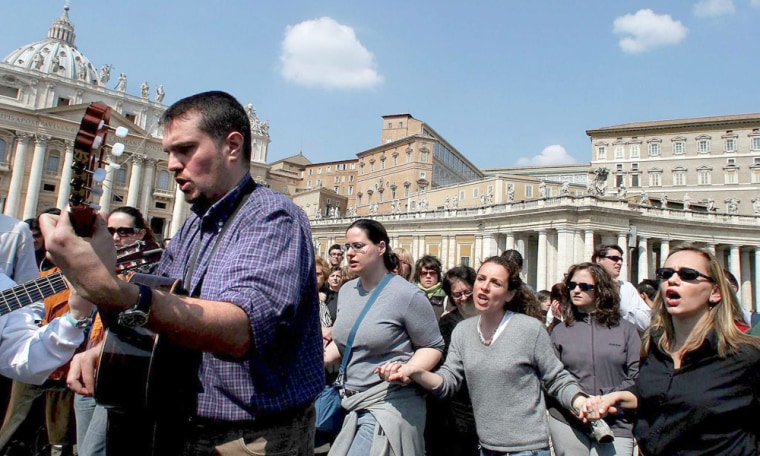Pope John Paul II remained in “very serious” condition Saturday after developing a high fever, but he was responding to members of his staff, the Vatican said.
“The clinical conditions of the Holy Father remain very serious. In late morning, the high fever developed. When addressed by members of his household, he responds correctly,” the Holy See said in a statement.
The 84-year-old pontiff was reported to have had a fever Thursday, which the Vatican blamed on a urinary tract infection that later led to heart and kidney failure. The Holy See did not say whether the fever had subsided at any time since or whether it was a new bout.
Light on in pope's apartment
At about the time Saturday’s communique was issued, a light went on in the pope’s third-floor apartment overlooking St. Peter’s Square, where an estimated 40,000 people were keeping vigil.
Papal spokesman Joaquin Navarro-Valls said earlier in the day that John Paul was not in a coma and opened his eyes when spoken to. But he added: “Since dawn this morning, there have been first signs that consciousness is being affected.”
“Sometimes it seems as if he were resting with his eyes closed, but when you speak to him he opens his eyes,” Navarro-Valls said.
But he said John Paul was not in a coma and opened his eyes when spoken to, Navarro-Valls said. But he did not take part when Mass was celebrated in his presence Saturday morning, he said.
One of John Paul’s closest advisers, Cardinal Joseph Ratzinger, told the Italian bishops’ news agency: “He’s aware he’s passing to the Lord.”
John Paul’s two secretaries, nursing staff and longtime personal physician were at his bedside.
The pope’s health began deteriorating Thursday after he suffered a urinary tract infection. By Friday, the Vatican said his heart and kidneys were failing.
Despite his frail condition, the pope remained alert and relaxed, according to church officials who had visited him.
Described as ‘placid, serene’
Vatican Cardinal Achille Silvestrini visited John Paul Saturday morning, accompanied by another cardinal, Jean-Louis Tauran.
“I found him relaxed, placid, serene. He was in his bed. He was breathing without labor. He looked like he lost weight,” Silvestrini said.
He said the when he and Tauran came into the room, the pope seemed to recognize them.
“The pope showed with a vibration of his face that he understood, indicating with a movement of his eyes. He showed he was reacting,” he added.
For a second day, the Vatican announced a series of papal appointments including a Spanish bishop, an official of the Armenian Catholic Church and ambassadors to El Salvador and Panama.
Tourists and pilgrims streamed anew into St. Peter’s Square on Saturday, and around the world, priests prepared Roman Catholics for the pope’s death. Many expressed hope that his final hours would be peaceful.
“Now he prepares to meet the Lord,” Cardinal Francis George said at a Mass in Chicago on Friday. “As the portals of death open for him, as they will for each of us ... we must accompany him with our own prayers.”
A workman in St. Peter's Square, declining to give his name, told the Associated Press that crews were taking down the canopy on the steps of St. Peter’s Basilica, which had covered an altar during Easter Sunday Mass. They said they had orders to clear the space for when the pope’s coffin eventually is carried into the square.
Several cardinals from the United States and Latin America said they were heading to Rome. After the official mourning period following the death of a pope, cardinals hold a secret vote in the Sistine Chapel to choose a successor.
The Il Secolo XIX newspaper of Genoa reported that the pope, with the help of his private secretary Archbishop Stanislaw Dziwisz, wrote a note to his aides urging them not to weep for him.
“I am happy, and you should be as well,” the note reportedly said. “Let us pray together with joy.”
However, Navarro-Valls said he couldn’t confirm the report, even after speaking to the pope’s secretary.
Picture of suffering
As word of his deteriorating condition spread across the globe, special Masses celebrated the pope for transforming the Roman Catholic Church during his 26-year papacy and for his example in fearlessly confronting death.
Hospitalized twice last month after breathing crises, and fitted with a breathing tube and a feeding tube, John Paul has become a picture of suffering.
His papacy has been marked by its call to value the aged and to respect the sick, subjects the pope has turned to as he battles Parkinson’s disease and crippling knee and hip ailments. The pope also survived a 1981 assassination attempt, when a Turkish gunman shot him in the abdomen.
In Washington, the White House said President Bush and his wife were praying for the pope and that the world’s concern was “a testimony to his greatness.”
Sharp decline
John Paul is suffering from septic shock and heart problems brought on by the urinary tract infection, the Vatican said.
Septic shock involves both bacteria in the blood and a consequent over-relaxing of the blood vessels. The vessels, which are normally narrow and taut, get floppy in reaction to the bacteria and can’t sustain any pressure. That loss of blood pressure is catastrophic, making the heart work hard to compensate for the collapse.
Dr. Gianni Angelini, a professor of cardiac surgery at Bristol University in England, said the chances of an elderly person in John Paul’s condition surviving septic shock more than 48 hours was no more than 20 percent, “but that would be in an intensive care unit with very aggressive treatment.”

